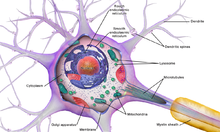Soma (biology)
This article needs additional citations for verification. (December 2008) |
In
oligodendrocytes,[2] and microglia.[3] There are many different specialized types of neurons, and their sizes vary from as small as about 5 micrometres to over 10 millimetres for some of the smallest and largest neurons of invertebrates
, respectively.

The soma of a neuron (i.e., the main part of the neuron in which the
axon terminals. Such transport of molecules towards and away from the soma maintains critical cell functions. In case of neurons, the soma receives a large number of inhibitory synapses,[5] which can regulate the activity of these cells. It has also been shown that microglial processes constantly monitor neuronal functions through somatic junctions, and exert neuroprotection when needed.[6]
The
RER) and polyribosomes. Within the axon hillock, materials are sorted as either items that will enter the axon (like the components of the cytoskeletal architecture of the axon, mitochondria, etc.) or will remain in the soma. In addition, the axon hillock also has a specialized plasma membrane that contains large numbers of voltage-gated ion channels, since this is most often the site of action potential initiation and triggering.[4]
The survival of some
receptors at axon terminals, and this produces a signal that must be transported up the length of the axon to the nucleus. A current theory of how such survival signals are sent from axon endings to the soma includes the idea that NGF receptors are endocytosed from the surface of axon tips and that such endocytotic vesicles are transported up the axon.[7]
Intermediate filaments are abundant in both perikarya and axonal and dendritic processes and are called
neurofilaments. The neurofilaments become cross linked with certain fixatives and when impregnated with silver, they form neuro fibrils visible with the light microscope. [8]
References
- S2CID 205438341.
- PMID 11274346.
- PMID 22457705.
- ^ ISBN 978-0-12-374019-9.
- ^ Freund and Katona, Neuron, Volume 56, Issue 1, 4 October 2007, Pages 33-42, https://doi.org/10.1016/j.neuron.2007.09.012
- S2CID 209343260.
- PMID 14699953.
- ^ Junqueira 12th edition.
External links
- Histology image: 3_09 at the University of Oklahoma Health Sciences Center - "Slide 3 Spinal cord"

